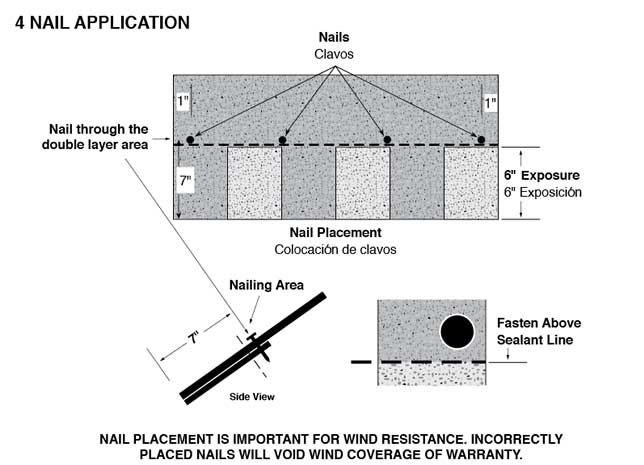
Three tab shingles (left) and architectural shingles (right)
All too often we observe sliding shingles during our inspections of laminate or architectural shingled roofs. To understand the cause of this phenomenon we must first look at how the architectural shingle is manufactured. An architectural shingle is actually manufactured in two different pieces. The top layer which has the cut out, or “pumpkin teeth” as I like to call them; and a bottom or back piece which is rectangular and located under the “pumpkin teeth.” The two layers are adhered with tar strips and this is what gives the architectural shingles a dimensional appearance.
As mentioned above, the shingles are held together by a tar strip during packaging and up to the time of installation. This tar strip is only designed to hold the shingle together prior to installation, it was never designed to support the weight of the back piece of the architectural shingle.

The manufacturer applies a nail line to the front of the shingle to ensure that the fasteners (nails) are placed in the correct location and properly securing the 2 pieces of the shingle together as the manufacturer intended. If the fasteners are placed above the nail line, as they often are, the back piece of the shingles is only held in place by the tar strip. During the warmer months the tar strips heat up, and the shingle begins to separate. The rectangular back piece of the shingle will begin to slide-out and depending on the pitch of the roof as to how quickly this becomes evident.
How to check if the misplaced or sliding shingles you’ve noticed are due to wind or improper installation
#1- If you find a rectangular piece (back piece) of the shingle in the gutter or in the yard, hold the shingle up and inspect the tar line to see if there are any nail holes, if there are no nail holes in the tar line you can rest assured that the shingles were installed improperly using a method we call “high-nailing”, meaning the nails were driven above the manufacturer’s suggested nail line.
#2- *Please err on the side of safety and employ a professional if the shingles are loose but still on the roof* If the back piece of the shingle looks to be sliding-out, gently lift the shingle located above the affected shingle (you may need a putty knife or flat edge to break the seal) and visually inspect the nail placement on the face of the shingle. The nail line will be approximately 6” from the bottom of the exposure or bottom of the shingle. The nail line is approximately ½” wide and runs the full length of the shingle. If the shingle has been installed correctly you may have wind-damage or a manufacturers defect.
Hopefully this will help determine the difference between wind-damaged shingles and improperly installed shingles. If you are a homeowner always ask for a workmanship warranty and inspect the roof for proper installation of the shingles.

 Our regular service area is Georgia, Alabama, Tennessee, North Carolina and South Carolina. Our catastrophe service area also includes Mississippi, Louisiana, Kentucky and Virginia. Doyen staff will travel outside this area in some circumstances. Please call with any requests.
Our regular service area is Georgia, Alabama, Tennessee, North Carolina and South Carolina. Our catastrophe service area also includes Mississippi, Louisiana, Kentucky and Virginia. Doyen staff will travel outside this area in some circumstances. Please call with any requests.
Recent Comments